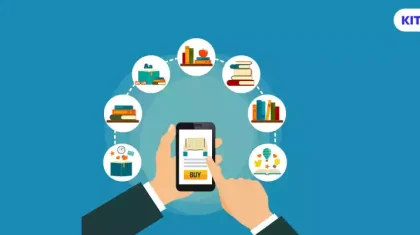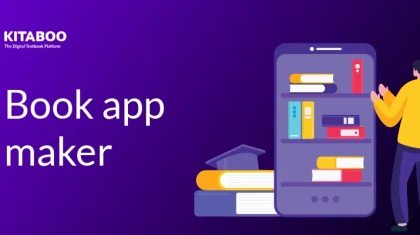
From Static PDFs to Interactive eBooks: A Transformation Roadmap for K12 Publishers
Summarize this blog with your favorite AI:
The physical and digital worlds are blurring with each passing day. Technology is seamlessly integrated into everything, from the smart devices in our homes to the personalized learning experiences revolutionizing education.
In this way, technology also changes the very nature of consumption, changing our relationship with the environment. In the same manner, it also changes the method of learning. Static PDFs, with their linear presentation and low interactivity, are relics from the past.
This blog will reveal critical changes from static PDFs to immersive experiences with digital textbook platforms like KITABOO. Interactive eBooks will enable K12 publishers to create appealing and effective learning experiences that are the true calling of the modern, tech-savvy student.
Table of Contents
I. The Limitations of Traditional Textbooks (PDFs)
II. The Rise of Interactive eBooks: A New Era in Education
- Improve Student Involvement
- Interactive Features
- Personalization of Learning
- Enhancing Learning Outcomes
III. Key Steps in the Transformation Process
- Content Repurposing and Assessment
- Defining Clear Learning Objectives
- Strategic Multimedia Integration
- Integrating Interactivity
- Ensuring Accessibility to All Learners
- Selection of Appropriate eBook Publishing Platform
- Pilot Testing and Refining
IV. Conclusion
The Limitations of Traditional Textbooks (PDFs)
Traditional textbooks, usually provided in PDF format, have several disadvantages in the fast-paced learning scenario of today:
1. Linear Learning Experience
PDFs inherently provide information in a linear, sequential manner. It tends to strangle critical thinking and creativity as students are taken through the material in a fixed sequence.
A recent study has shown that the engagement level is higher and understanding is deeper in non-linear, interactive learning materials.
2. Lack of Engagement and Interactivity
Most static PDFs cannot capture or maintain students’ attention. Videos, animations, quizzes, and other interactive elements achieve less engagement, which results in passive learning and reduced comprehension.
A recent study reveals that interactive content can significantly increase students’ motivation and engagement and improve their knowledge retention.
3. Limited Accessibility
Some students have difficulty accessing PDFs. Students with visual impairments may have trouble reading the text, and students who have problems processing sounds may struggle to read long pieces of text.
Moreover, PDFs are not often very flexible in meeting the different learning styles of the learners, as some require alternative formats or even assistive technology.
Such limitations, therefore, point towards a more vibrant, interesting method for presenting educational material and, therefore, necessitate interactive as well as individualized learning experiences.
The Rise of Interactive eBooks: A New Era in Education
Interactive eBooks are a new educational dimension, taking the learning process beyond the confines of static PDFs. Adding multimedia elements and engaging interactivity turns learning from a passive experience to an active and immersive journey.
1. Improve Student Involvement
Interactive eBooks are very engaging for a student as features are dynamic and break the dullness of text. Videos, audio clips, and animations incorporate learning into actual life scenarios, making intangible concepts into tangible ones with ease.
2. Interactive Features
Quizzes, games, and simulations convert a passive read into an interactive activity. The ability of a student to check their understanding through testing, applying concepts, and getting instant feedback makes them highly engaged and automatically ingrain key learning objectives.
3. Personalization of Learning
Interactive eBooks can be customized to suit individual learning styles and paces. Students can adjust text size, font, and reading speed and navigate through content at their own pace. Adaptive learning features can provide personalized recommendations and adjust the difficulty level based on individual progress.
4. Enhancing Learning Outcomes
Interactive eBooks enhance learning outcomes by actively engaging students and providing immediate feedback. Studies have shown that students who interact with multimedia-rich content have improved comprehension, retention, and critical thinking skills.
Key Steps in the Transformation Process
The transition from static PDFs to interactive eBooks calls for a lot of effort in disseminating digital textbooks in schools. This process demands a multifaceted approach, which consists of proper planning, thorough execution, and constant refinement.
1. Content Repurposing and Assessment
A thorough assessment of all the PDFs is first observed with any journey. This consists of finding significant concepts, flowing information, and the general effective use of content. The analytical process guides repurposing so that the adaptive enhancement of present content for new interactive purposes comes into play.
2. Defining Clear Learning Objectives
Learning objectives play a vital role in implementing multimedia in educational materials because they are able to define precisely what students need to learn from the eBook. Thus, determining multimedia elements and interaction features ensures that it serves the student well in terms of learning.
3. Strategic Multimedia Integration
The strategic use of multimedia elements is very important. Videos might make complex ideas more meaningful, audio clips may provide authentic pronunciations or historical accounts, and animations can make abstract concepts real. It is, therefore, important to choose multimedia elements that are relevant, engaging, and specific to the learning objectives.
4. Integrating Interactivity
Interactive elements have been the spine of engaging e-books. Quizzes, games, simulations, and interaction exercises make static reading an active learning experience. These activities not only maximize student engagement with interactive content but also provide them with instant feedback. Hence, a student can examine their understanding and improvement areas.
5. Ensuring Accessibility to All Learners
Accessibility is important. Interactive eBooks must be created in an inclusive and accessible way for students. They must include the needs of students with disabilities, with features like text-to-speech functionality, variable font size, and alt-text for images.
6. Selection of Appropriate eBook Publishing Platform
A good platform for eBook development and distribution is of utmost importance. A solid educational eBook publishing platform like KITABOO is necessary to design, develop, publish, and distribute high-quality interactive eBooks.
7. Pilot Testing and Refining
Pilot testing has to be very in-depth by a representative sample of students and instructors. This gives publishers a better understanding of needs and creates opportunities for improvement, design refinement, and usability of the eBook, thereby creating an optimal learning experience for all users.
Conclusion
Converting PDFs to interactive eBooks is an important step K12 publishers must take. By embracing innovation and using high-powered platforms such as KITABOO, they can develop learning experiences that will excite and help their students learn effectively, enabling them to succeed in the 21st century.
Contact us today to learn how our platform can help you transform static PDFs into interactive eBooks.
Also check:
- Digital Textbook Platform for K12 Publishers
- Digital Textbook Platform for Associations & Societies
- Digital Textbook Platform for Trade Publishers
- Digital Textbook Platform for Training Companies
- Digital Publishing Solution for Content Aggregators
- Digital Publishing Platform for Professional Training
Discover how a mobile-first training platform can help your organization.
KITABOO is a cloud-based platform to create, deliver & track mobile-first interactive training content.


